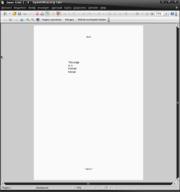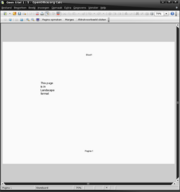CCNC/CCNC Module 4/Spreadsheets/Application/Settings
Adjusting Settings
The Calc application comes with some standard specifications in terms of size of the spreadsheet and the worksheet, layout of the work area among other things. You can choose to change the standard settings, depending on your requirements as the user of the application.
Now do it
Change the scale of the spreadsheet
Often when working with spreadsheets it is convenient to enlarge or reduce the spreadsheet in the work area. Suppose the spreadsheet Demog.sxc is loaded.
SCREENSHOT
To change the scale of the spreadsheet,
- Click on View, then Zoom. This displays the Zoom dialogue that provides you with various options for adjusting size. These are expressed as percentages, with the standard being 100%. Values less than 100% will reduce the spreadsheet, while values greater than 100% will enlarge it.
- Click the appropriate radio button to scale the spreadsheet (for example 150%).
- Experiment with the other values in the Zoom dialogue.
(![]() : I have not yet looked at Cheryl's editing guidelines but I think there is need for a standard format for the extensions on the task statement, when these occur (like the one above). These typically describe the outcome of the task just completed before proceeding to the next, or amplify or explain the task itself.)
: I have not yet looked at Cheryl's editing guidelines but I think there is need for a standard format for the extensions on the task statement, when these occur (like the one above). These typically describe the outcome of the task just completed before proceeding to the next, or amplify or explain the task itself.)
Change Page width
A useful zoom is Page width. This displays the width of the printed page on the screen. The degree of enlargement or reduction depends on whether the Page setup is portrait or landscape. To see the difference, follow the instructions below:
Page width in portrait- Click on Format, then Page
- Click the Page tab, then under Orientation, click the Portrait radio button
- Click the Page width radio button, then click OK
- Click on Format, then Page.
- Click the Page tab, then under Orientation, click the Landscape radio button
- Click on View, then Zoom
- Click the page Width radio button, then click OK.
(![]() : Terms for Course/Module Glossary - tab, radio button, icon, cursor. Glossary may also be pictorial to enhance verbal explanation, where appropriate.)
: Terms for Course/Module Glossary - tab, radio button, icon, cursor. Glossary may also be pictorial to enhance verbal explanation, where appropriate.)
Display, hide built-in toolbars
Calc has a number of standard toolbars. Which of these are displayed depends on how your system was set up. You can decide which toolbars you wish to have displayed.
- Click on View, then Toolbars
SCREENSHOT
A list of toolbars is displayed. The ticked toolbars are visible on the screen.
- Click on Function Bar
SCREENSHOT
The Function Bar is now hidden. To unhide the Function bar,
- Click on View, then Toolbars
- Click on Function bar.
(![]() : I cant remember if 'toolbar' was included as one of the Calc features explained at the beginning of this section. If not it should be included as one of the bars there. When that is done a slight adjustment must be made to the text of this segment)
: I cant remember if 'toolbar' was included as one of the Calc features explained at the beginning of this section. If not it should be included as one of the bars there. When that is done a slight adjustment must be made to the text of this segment)
Applying the function Full Screen has a similar effect.
- Click on View, then Full Screen. This hides the toolbars.
SCREENSHOT
- Click the Full Screen icon in the top left hand corner of the screen. This restores (unhides) the toolbars.
Freeze, unfreeze row and/or column headings
Certain rows and columns are often used for inputting headings. If you scroll down or to the right, these headings will scroll off the screen. To keep the headings on the screen while data scrolls off the screen, we can freeze the rows or columns containing the headings.
Consider the spreadsheet shown on the next screen.
SCREENSHOT
Notice the column headings in row 3 and the row headings in Column A. If you were to scroll down and across, these headings would disappear off the screen.
SCREENSHOT
We can freeze the headings as follows:
- Position the cursor in the cell immediately below the column heading and in the column immediately to the right of the row headings. In this case it is the cell B4.
- Click on Window, then Freeze.
If you were to scroll down and across, the headings would remain on the screen as shown below.
SCREENSHOT
In this case both rows and columns are frozen. If you wish to freeze only rows, position the cursor in column A, then Windows->Freeze. If you wish to freeze only columns, position the cursor in row 1, then Windows->Freeze.
Modify default options
Calc allows you to alter some basic default data and/or set up your own from scratch.
Modify user name and data
- Click on Tools, then Options.
- Click on the + symbol to expand OpenOffice.org
- Click on User Data. A blank form is displayed.
- Fill in your user data
- Click OK.
SCREENSHOT
Set default directory
When opening or saving files, , Calc will, b y default, look in a certain directory. This can be set as follows:
- Click on Tools, then Options
- Click on the + symbol to expand OpenOffice.org
- Click on Paths
- Double click on My Documents
SCREENSHOT
- Locate the desired path using the Select Path dialogue
- Click Select
Change default spreadsheet type
The default, Calc, saves spreadsheets in Calc format. This will have an sxc extension. You may have to share your work with users who use other spreadsheet programs. In this case you could change the default format to that of another product, for example, Microsoft Excel.
- Click on Tools, then Options
- Click Load/Save
- Click on General
- Under Document Type, select Spreadsheets
- Under Always save as, select the format you wish to use as your default.
- Click OK
SCREENSHOT
Change other settings
Several other settings may be set using the same route of Tools->Options
- Click on Tools, then Options
- Expand Spreadsheets
- Select the section in which you wish to adjust settings. For example, General - You set measurement units and tab stops here. View - you change the colour of gridlines here; you may also decide whether formulas and values are shown by clicking in the appropriate box or radio button to select or deselect the setting.
- Scroll through the different options to get a feel of the range of settings.
SCREENSHOT
- Are the terms 'symbol' and 'icon' synonymous? Need to check.
- I cant remember if the term 'gridlines' was included in the earlier explanation of rows and columns. If not that segment should be revised to include the term there.)


